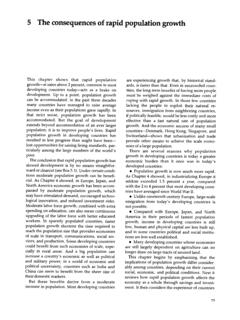Transcription of Iron-Status Indicators
1 National Report on Biochemical Indicators of Diet and Nutrition in the population 1999-2002 Iron-Status Indicators Iron functions as a component of proteins and enzymes. Almost two-thirds of the iron in the body (approximately grams of iron) is found in hemoglobin, the protein in red blood cells that carries oxygen to tissues, and about 15 percent is in the myoglobin of muscle tissue. The average American diet provides 10 15 milligrams (mg) of iron daily in the form of heme and nonheme iron. Heme iron is found in animal foods that originally contained hemoglobin and myoglobin, such as red meat, fish, and poultry.
2 Nonheme iron is found in plant foods, such as lentils and beans, and also is provided in iron-enriched and iron-fortified foods. Although heme iron is absorbed better than nonheme iron, most dietary iron is nonheme iron (Miret 2003). Each day the body absorbs approximately 1 2 mg of iron to compensate for the 1 2 mg of iron that the (nonmenstruating) body loses (Institute of Medicine 2001). Transporting iron from one organ to another is accomplished by the reversible binding of iron to the transport protein, transferrin, which will then form a complex with a highly specific transferrin receptor (TfR) located on the plasma membrane surfaces of cells.
3 Intracellular iron availability is regulated through the increased expression of cellular TfR concentration by iron-deficient cells. Ferritin is the major iron-storage compound: its production increases in cells as iron supplies increase. Although all cells are capable of storing iron, the liver, spleen, and bone marrow cells are primary iron-storage sites in people (Institute of Medicine 2001). Iron deficiency and iron overload are the two major disorders of iron metabolism. Iron-deficiency anemia is the most severe form of iron deficiency. It is linked to many adverse consequences of iron deficiency, such as reduced physical capacity (Haas 2001) and poor pregnancy outcomes (Schorr 1994).
4 Iron deficiency without anemia, however, has been linked to negative effects on cognitive development among infants and adolescents (Grantham-McGregor 2001; Beard 1999). Iron overload is the accumulation of excess iron in body tissues, and it usually occurs as a result of a genetic predisposition to absorb iron in excess of normal but can also be caused by excessive ingestion of iron supplements or multiple blood transfusions (Pietrangelo 2004). In advanced stages of iron overload 3 Iron-Status Indicators 73 Medical technologist places samples for ferritin measurement into a clinical analyzer.
5 Disease (hemochromatosis), the iron accumulates in the parenchymal cells of several organs, but particularly the liver, followed by the heart and pancreas; this condition can lead to organ dysfunction and even death (Pietrangelo 2004). The Recommended Dietary Allowance (RDA) for all age groups of men and postmenopausal women is 8 mg per day; the RDA for premenopausal women is 18 mg per day. The Tolerable Upper Uptake Level for adults is 45 mg per day of iron, a level based on gastrointestinal distress as an adverse effect (Institute of Medicine 2001).
6 Clinical laboratories typically use conventional units for Iron-Status Indicators : iron, total iron-binding capacity (TIBC), and erythrocyte protoporphyrin (EPP) are calculated in micrograms per deciliter ( g/dL), ferritin in nanograms per milliliter (ng/ mL). Conversion factors to international system (SI) units are as follows: 1 g/dL = micromole per liter ( mol/L) for iron and TIBC, 1 g/dL = mol/L for EPP, and 1 ng/mL = picomole (pmol)/L for ferritin. Several methods are used to measure iron and related analytes. Serum iron concentration measures the amount of ferric iron (Fe3+) bound mainly to serum transferrin but does not include the divalent iron contained in serum as hemoglobin.
7 Serum iron concentration is decreased in many people with iron-deficiency anemia and in people with chronic inflammatory disorders. Elevated concentrations of serum iron occur in iron-loading disorders such as hemochromatosis. Serum iron is not, however, a good indicator of iron stores and is not a sensitive measure of iron deficiency, partly because of daily fluctuations. For enhanced utility, serum iron measurements are used in conjunction with TIBC measurements. Normally, because only about one third of the iron-binding sites of transferrin are occupied by Fe3+, serum transferrin has considerable reserve iron-binding capacity.
8 TIBC is a measurement of serum transferrin after saturation of all available binding sites with reagent iron. Concentrations of serum TIBC vary with the type of iron-metabolism disorder. For example, in iron deficiency TIBC is often increased, and in chronic inflammatory disorders, malignancies, and hemochromatosis, it is often decreased. The ratio of serum iron to TIBC is called transferrin saturation. Low iron values in conjunction with elevated TIBC values (or specifically measured transferrin concentrations), yielding less than 16 percent transferrin saturation, generally indicate iron-deficiency anemia (World Health Organization 2001).
9 Transferrin saturation values in excess of 60 percent may be indicative of hemochromatosis or iron overload (World Health Organization 2001). National Report on Biochemical Indicators of Diet and Nutrition in the population 1999-2002 74 Ferritin is present in the blood in very low concentrations. Plasma ferritin is in equilibrium with body stores, and its concentration declines early in the development of iron deficiency. Low serum ferritin concentrations thus are sensitive Indicators of iron deficiency. Ferritin is also an acute-phase protein; acute and chronic diseases can result in increased ferritin concentration, potentially masking an iron-deficiency diagnosis.
10 The generally accepted cut-off level for serum ferritin below which iron stores are considered to be depleted is 15 ng/mL for people aged 5 years and older and 12 ng/mL for people younger than 5 years of age (World Health Organization 2001). Finally, when iron delivery to the bone marrow is not sufficient for maintaining the incorporation of iron into newly synthesized globin and porphyrin protein, EPP concentrations increase. Yet EPP is not useful to distinguish iron deficiency from infection and also elevates in response to lead poisoning (Roels 1975).












